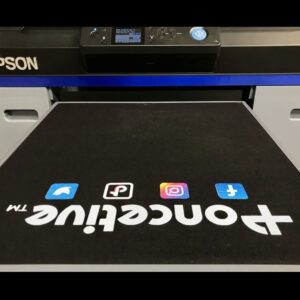So What Printing Method is Best for Your Job?
There are benefits to both traditional Screen Printing and Direct-to-Garment (DTG) Printing. We are breaking down both to help you decide what is best for your next order!
Screen Printing and DTG Printing are both methods of printing custom designs onto fabrics.
Screen Printing is the more traditional technique that involves pushing the ink onto the t-shirt fabric through a stencil, while DTG is a newer method that uses a printer to apply the ink to the shirt. DTG printing involves the use of a digital printer to apply ink directly onto the fabric of the apparel you’re customizing. This is a newer t-shirt printing method that’s gained a lot of popularity in recent years thanks to technological improvements in DTG printers. DTG printing creates a precisely printed design with a high level of detail.
DTG Printing leaves a single layer of ink to create your final design, while screen printing produces several layers. This has a few important effects, particularly on how you use color in your design.
- Screen Printing produces a vibrant, durable design with more saturated colors than the DTG process. However, the labor-intensive process of turning your design into multiple stencils limits the number of colors you can use.
- DTG Printing produces a slightly more faded design with a single layer of ink, but with no limits on the number of colors you can use. There are some limitations that make certain color combinations difficult, though. For example, it can be tricky for digital printers to create designs with light-colored ink on dark fabrics.
There are certain types of t-shirt designs are better suited to each method. Simpler, stylized designs with graphics or text in a handful of colors are great for screen printing, while DTG printing can handle more elaborate designs in more colors, usually on light-colored fabric.
Screen Printing Costs

Screen Printing is most cost-effective for larger batches of shirts. The stencil process means that set-up costs are a little higher, but it also makes screen printing more efficient for large orders of one design.
Using more than the recommended number of colors slows down the process, though, resulting in higher final prices, since each color used needs its own screen stencil created.
But with screen printing, there are typically cost savings built-in as you print more t-shirts! Having master stencils for each layer streamlines the process as more shirts are printed.
DTG Costs

DTG printing is most cost-effective for small batches of custom printed t-shirts. The number of colors used won’t seriously affect the final price.
However, large batches will use more ink and time — the printer can only handle one shirt at a time — resulting in higher prices. DTG printing typically does not offer bulk savings the way that screen printing does.
So, with all the details above, think about your custom t-shirt printing project and which process will be best suited for it. Need help deciding? Give us a call and we would be happy to help guide you in the right direction.
